
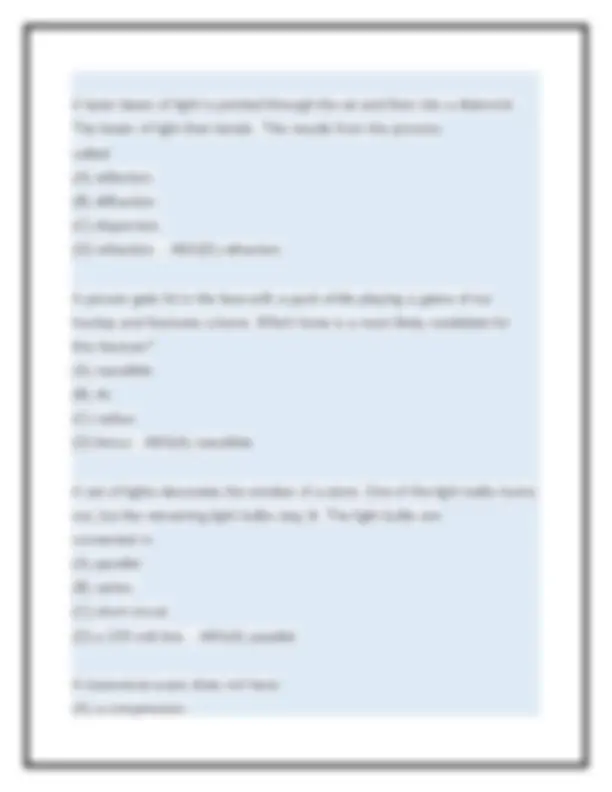
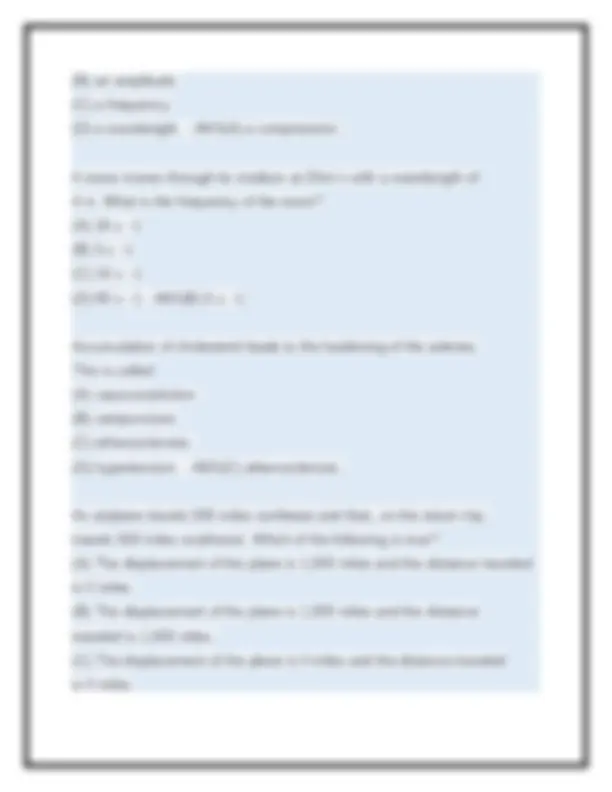
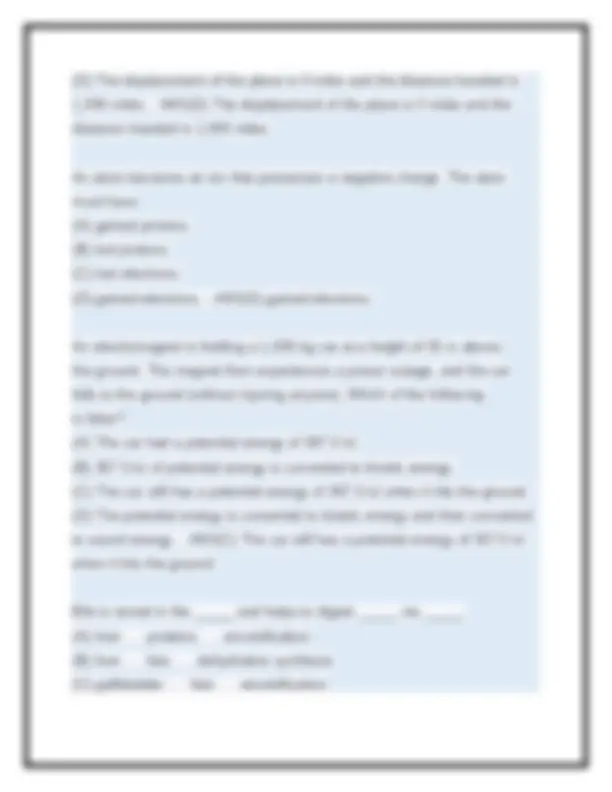
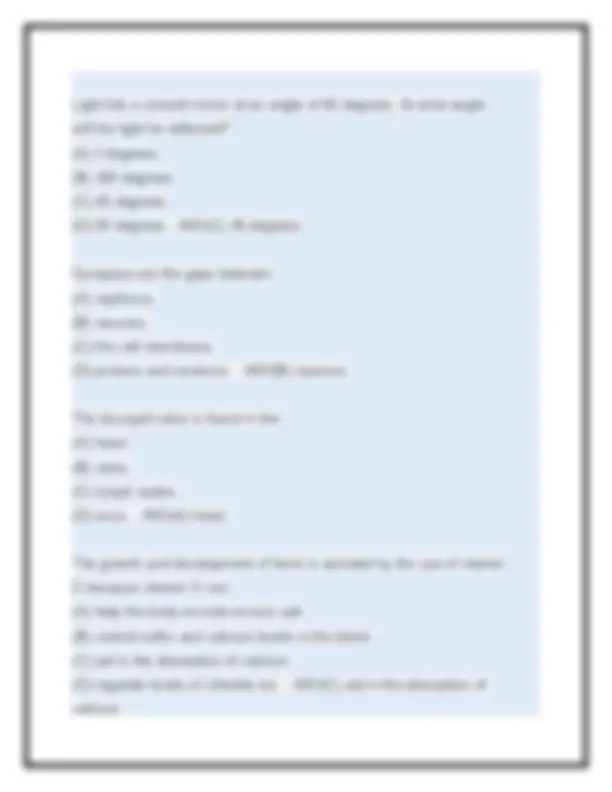
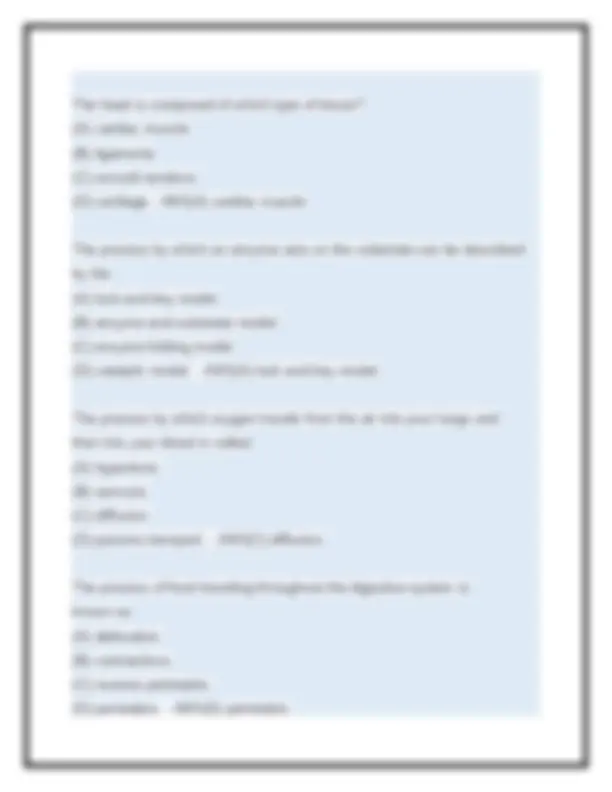
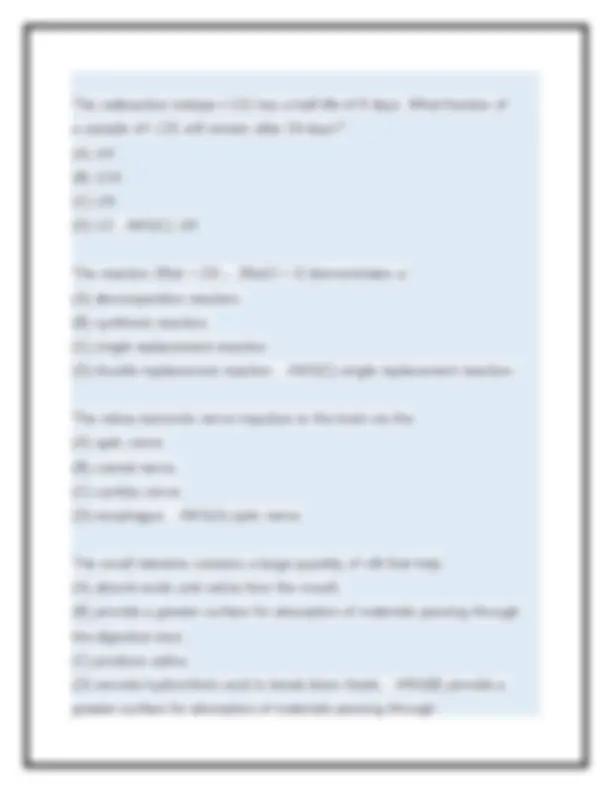
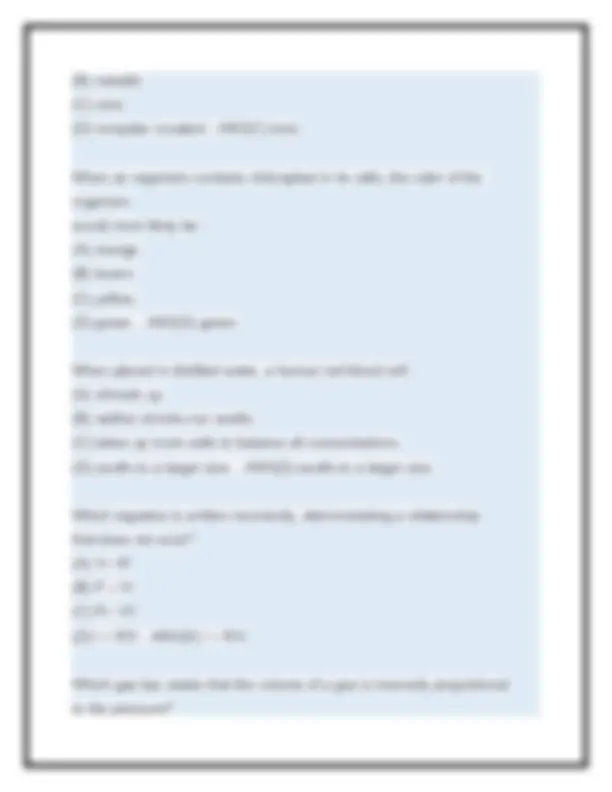
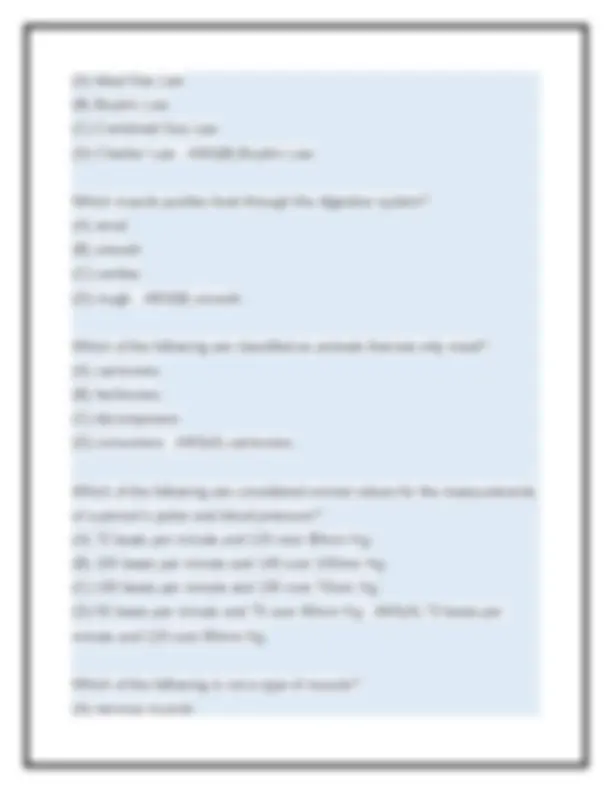
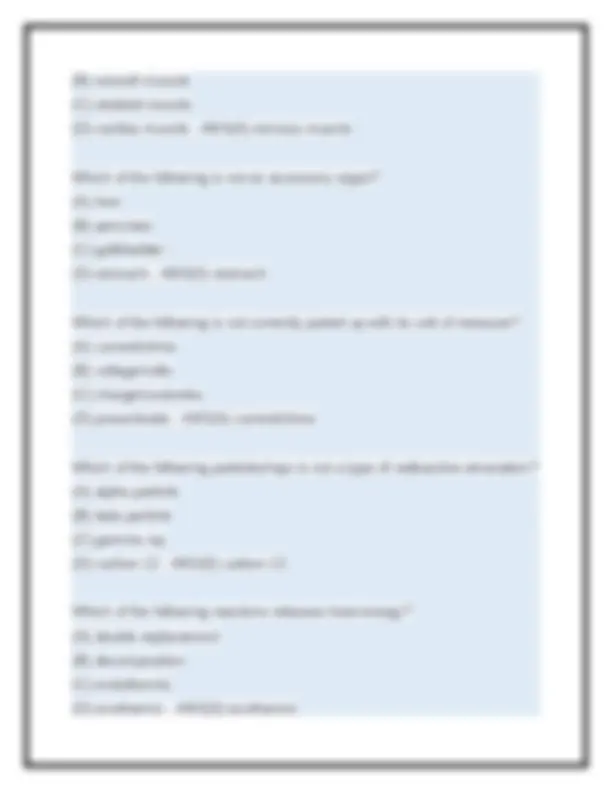


Study with the several resources on Docsity

Earn points by helping other students or get them with a premium plan


Prepare for your exams
Study with the several resources on Docsity

Earn points to download
Earn points by helping other students or get them with a premium plan
Community
Ask the community for help and clear up your study doubts
Discover the best universities in your country according to Docsity users
Free resources
Download our free guides on studying techniques, anxiety management strategies, and thesis advice from Docsity tutors
Science NLN Practice Questions and Verified Answers Updated 2025 Graded A
Typology: Exams
1 / 16

This page cannot be seen from the preview
Don't miss anything!










A 10-kg object moving at 5m/ s has an impulse acted on it causing the velocity to change to 15m/s. What was the impulse which was applied to the object? (A) 10 kg·m/s (B) 20 kg·m/s (C) 15 kg·m/s (D) 100 kg·m/s - ANS(D) 100 kg·m/s A 110-volt appliance draws 2.0 amperes. How many watts of power does it require? (A) 220 watts (B) 55 watts (C) 112 watts (D) 108 watts - ANS(A) 220 watts A 110-volt hair dryer delivers 1,525 watts of power. How many amperes does it draw? (A) 167,750 amperes (B) 1,635 amperes (C) 1,415 amperes (D) 13.9 amperes - ANS(D) 13.9 amperes
A 60-watt light bulb is powered by a 110-volt power source. What is the current being drawn? (A) 1.83 amperes (B) 0.55 amperes (C) 50 amperes (D) 6,600 amperes - ANS(B) 0.55 amperes A certain substance is not broken down in a chemical reaction. The substance is most likely (A) a compound. (B) an aqueous solution. (C) an element. (D) a heterogeneous mixture. - ANS(C) an element. A force of 10 N is delivered to an object for 1.5 seconds. What is the impulse directed on the object? (A) 15 N·s (B) 8.5N (C) 11.5 s (D) 6.7 N/s - ANS(A) 15 N·s A hydrogen ion concentration of 1 × 10−7 M in a solution is considered (A) basic. (B) alkali. (C) acidic. (D) neutral. - ANS(D) neutral.
(B) an amplitude. (C) a frequency. (D) a wavelength. - ANS(A) a compression. A wave moves through its medium at 20m/ s with a wavelength of 4 m. What is the frequency of the wave? (A) 24 s − (B) 5 s − (C) 16 s − (D) 80 s −1 - ANS(B) 5 s − Accumulation of cholesterol leads to the hardening of the arteries. This is called (A) vasoconstriction. (B) venipuncture. (C) atherosclerosis. (D) hypertension. - ANS(C) atherosclerosis. An airplane travels 500 miles northeast and then, on the return trip, travels 500 miles southwest. Which of the following is true? (A) The displacement of the plane is 1,000 miles and the distance traveled is 0 miles. (B) The displacement of the plane is 1,000 miles and the distance traveled is 1,000 miles. (C) The displacement of the plane is 0 miles and the distance traveled is 0 miles.
(D) The displacement of the plane is 0 miles and the distance traveled is 1,000 miles. - ANS(D) The displacement of the plane is 0 miles and the distance traveled is 1,000 miles. An atom becomes an ion that possesses a negative charge. The atom must have (A) gained protons. (B) lost protons. (C) lost electrons. (D) gained electrons. - ANS(D) gained electrons. An electromagnet is holding a 1,500-kg car at a height of 25 m above the ground. The magnet then experiences a power outage, and the car falls to the ground (without injuring anyone). Which of the following is false? (A) The car had a potential energy of 367.5 kJ. (B) 367.5 kJ of potential energy is converted to kinetic energy. (C) The car still has a potential energy of 367.5 kJ when it hits the ground. (D) The potential energy is converted to kinetic energy and then converted to sound energy. - ANS(C) The car still has a potential energy of 367.5 kJ when it hits the ground. Bile is stored in the _____ and helps to digest _____ via _____. (A) liver... proteins... emulsification (B) liver... fats... dehydration synthesis (C) gallbladder... fats... emulsification
(D) cytoplasmosis. - ANS(B) cytokinesis. Electrical potential is measured in (A) ohms. (B) watts. (C) amperes. (D) volts. - ANS(D) volts. If a salt is added to water, which of the following is likely to occur? (A) The boiling point will increase and the freezing point will decrease. (B) The boiling point will increase and the freezing point will increase. (C) The boiling point will decrease and the freezing point will decrease. (D) The boiling point will decrease and the freezing point will increase. - ANS(A) The boiling point will increase and the freezing point will decrease. In most living things, all of the following groups of chemicals can be found naturally EXCEPT (A) lipids. (B) synthetic polymers. (C) nucleic acids. (D) carbohydrates. - ANS(B) synthetic polymers. In which phase of mitosis do the chromosomes line up? (A) interphase (B) metaphase (C) prophase (D) anaphase - ANS(B) metaphase
Light hits a smooth mirror at an angle of 45 degrees. At what angle will the light be reflected? (A) 0 degrees (B) 180 degrees (C) 45 degrees (D) 90 degrees - ANS(C) 45 degrees Synapses are the gaps between (A) nephrons. (B) neurons. (C) the cell membrane. (D) protons and neutrons. - ANS(B) neurons. The bicuspid valve is found in the (A) heart. (B) veins. (C) lymph nodes. (D) anus. - ANS(A) heart. The growth and development of bone is assisted by the use of vitamin D because vitamin D can (A) help the body excrete excess salt. (B) control sulfur and calcium levels in the blood. (C) aid in the absorption of calcium. (D) regulate levels of chloride ion. - ANS(C) aid in the absorption of calcium.
The radioactive isotope I-131 has a half-life of 8 days. What fraction of a sample of I-131 will remain after 24 days? (A) 1⁄ (B) 1⁄ (C) 1⁄ (D) 1⁄2 - ANS(C) 1⁄ The reaction 2NaI + Cl2→ 2NaCl + I2 demonstrates a (A) decomposition reaction. (B) synthesis reaction. (C) single replacement reaction. (D) double replacement reaction. - ANS(C) single replacement reaction. The retina transmits nerve impulses to the brain via the (A) optic nerve. (B) cranial nerve. (C) cardiac nerve. (D) esophagus. - ANS(A) optic nerve. The small intestine contains a large quantity of villi that help (A) absorb acids and salvia from the mouth. (B) provide a greater surface for absorption of materials passing through the digestive tract. (C) produce saliva. (D) secrete hydrochloric acid to break down foods. - ANS(B) provide a greater surface for absorption of materials passing through
The stomach and mouth are connected by the (A) anus. (B) esophagus. (C) spinal column. (D) epiglottis. - ANS(B) esophagus. The strongest acid can be found in which of the following pH ranges? (A) 11.1− (B) 7.1−8. (C) 4.5−5. (D) 1.0−2.0 - ANS(D) 1.0−2. The symbol K on the periodic table stands for (A) potassium. (B) calcium. (C) carbon. (D) phosphorus. - ANS(A) potassium. The symbol Ω represents (A) current. (B) resistance. (C) amperes. (D) power. - ANS(B) resistance. The word renal refers to the (A) liver.
(B) metallic (C) ionic (D) nonpolar covalent - ANS(C) ionic When an organism contains chloroplast in its cells, the color of the organism would most likely be (A) orange. (B) brown. (C) yellow. (D) green. - ANS(D) green. When placed in distilled water, a human red blood cell (A) shrivels up. (B) neither shrinks nor swells. (C) takes up more salts to balance all concentrations. (D) swells to a larger size. - ANS(D) swells to a larger size. Which equation is written incorrectly, demonstrating a relationship that does not exist? (A) V= IR (B) P = IV (C) R= V/I (D) I = R/V - ANS(D) I = R/V Which gas law states that the volume of a gas is inversely proportional to the pressure?
(A) Ideal Gas Law (B) Boyle's Law (C) Combined Gas Law (D) Charles' Law - ANS(B) Boyle's Law Which muscle pushes food through the digestive system? (A) renal (B) smooth (C) cardiac (D) rough - ANS(B) smooth Which of the following are classified as animals that eat only meat? (A) carnivores (B) herbivores (C) decomposers (D) consumers - ANS(A) carnivores Which of the following are considered normal values for the measurements of a person's pulse and blood pressure? (A) 72 beats per minute and 120 over 80mm Hg (B) 100 beats per minute and 140 over 100mm Hg (C) 160 beats per minute and 100 over 70mm Hg (D) 55 beats per minute and 75 over 60mm Hg - ANS(A) 72 beats per minute and 120 over 80mm Hg Which of the following is not a type of muscle? (A) nervous muscle
Which of the following wavelengths of visible light is best absorbed by chlorophyll? (A) 300nm (B) 495nm (C) 665nm (D) 550nm - ANS(C) 665nm White light enters a prism and is broken up into the colors of the rainbow. This phenomenon is called (A) reflection. (B) diffraction. (C) dispersion. (D) refraction. - ANS(C) dispersion.